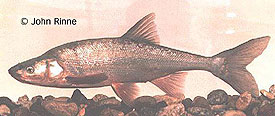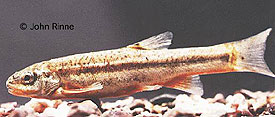|
Fossil
Creek Watershed
and Riparian Restoration
Native Fish
Restoration

Roundtail Chub
Native Arizona fishes are among the most
endangered group of aquatic species in the United States. Twenty of
the 35 native species (54%) are listed as either endangered or threatened. Human utilization of land and water resources has dramatically affected
streams and rivers in the Southwest, resulting in significant effects to
native fishes. Compounding these effects are predatory non-native
fish, crayfish and bullfrogs that have decimated or eliminated populations
of native fish.
Since the early 1900s, at least 40 species of
non-native fish have become established in the Gila River Basin in which
Fossil Creek is located. Many of these non-natives were purposefully
introduced to increase the diversity of the sport fishery, and some were
accidentally released as bait or ornamental fish. Regardless of the
mode of arrival, non-native fishes have had a detrimental affect on native
aquatic species. The introduction and proliferation of non-native
aquatic species, especially fish, is increasingly viewed as one of the most
serious long-term threats to the recovery of native species, equaled in
severity only by the effect of habitat destruction.
The introduced fish species that proliferate
in the Verde River and threaten Fossil Creek evolved in the Great Lakes and
Mississippi drainage systems, but are not native to the Colorado, Gila, or
other western river basins. Non-native fish that have invaded Fossil
Creek include the green sunfish, smallmouth bass,, flathead catfish, and
yellow bullhead.
The Bureau of Reclamation, the
Forest Service (Coconino and Tonto National Forests), U.S. Fish and Wildlife
Service, and the Arizona Game and Fish Department partnered to complete
a project to restore native fishes to Fossil Creek. Field work on the Fossil
Creek Native Fish Restoration Project began in the fall of 2004. Work
was completed in November 2004. Monitoring will continue for
to determine if restoration goals for the project were met.
For more information about native fish in Arizona, go to the
Native Fish Lab at ASU.
For additional information
regarding the native fish restoration project, see the information below as
well as the Research and Photos sections of this website.
View Fossil Creek
Restoration: An Ecological Experiment (from Econotes, Volume 1, a
publication of the Stream Ecology and Restoration Group at Northern Arizona
University)
Word document (2.17 MB)
PDF (194 KB)
View the Decision Notice and Finding of No
Significant Impact (U.S. Forest Service, Coconino and Tonto National
Forests, June 8, 2004)
Word document (112 KB)
PDF (106 KB)
Link to the Forest Service webpage to
download the Draft Environmental Assessment (December 2003) (3.7 MB):
http://www.fs.fed.us/r3/coconino/nepa/index.shtml

Speckled Dace
Home
NAU Watershed Restoration: An Overview
Baseline Conditions
Long-Term Monitoring Plan
Participatory Meetings
Facility Decommissioning
Management Recommendations
Forest Service Fossil Creek Info
Research
Photos
Links
|
